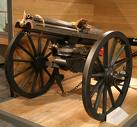Gatling Gun
 Inventor Richard Jordan Gatling was born in Hertford County in September 1818. Issued his first patent in 1844 for a rice-seed planter, he soon moved to St. Louis, Mo., and successfully marketed the machine as a wheat-drill. More inventions followed, including a steam plow, a cotton cultivator, and a hemp brake. A Unionist, Gatling was living in Indianapolis in 1862 when he patented his first machine gun, employing a cartridge-feeding mechanism adapted from his rice-seed planter. Initial models, built by a Cincinnati firm, had a single barrel fed by a rotary chamber and fired 190 bullets per minute. The Federal Ordnance Department showed no interest, but Gen. Benjamin F. Butler purchased 13 and used them at Bermuda Hundred, near Richmond, in the spring of 1863. As results were inconclusive, the gun saw no further service in the Civil War, although the navy ordered a small number.
Inventor Richard Jordan Gatling was born in Hertford County in September 1818. Issued his first patent in 1844 for a rice-seed planter, he soon moved to St. Louis, Mo., and successfully marketed the machine as a wheat-drill. More inventions followed, including a steam plow, a cotton cultivator, and a hemp brake. A Unionist, Gatling was living in Indianapolis in 1862 when he patented his first machine gun, employing a cartridge-feeding mechanism adapted from his rice-seed planter. Initial models, built by a Cincinnati firm, had a single barrel fed by a rotary chamber and fired 190 bullets per minute. The Federal Ordnance Department showed no interest, but Gen. Benjamin F. Butler purchased 13 and used them at Bermuda Hundred, near Richmond, in the spring of 1863. As results were inconclusive, the gun saw no further service in the Civil War, although the navy ordered a small number.
 Postwar models, using new self-contained brass (rather than paper) cartridges, had six barrels hand-cranked around a central shaft. This design, the first successful machine gun, impressed the army, which bought 100 in 1866. Although Gatling continued to invent mainly agricultural and military machines and implements, he built his career around improving and publicizing his machine gun, manufactured by Colt's Armory in Hartford, Conn., and later by an English firm at Newcastle-on-Tyne. The gun was used by France in the Franco-Prussian War and against Indians in the American West and adopted by Russia, England, Austria-Hungary, Egypt, and other countries. Later models fired up to 3,000 rounds per minute. American Gatling guns saw service in the Spanish-American War, but by this time the weapon had lost ground to the Nordenfeldt and Maxim guns and other machine guns that were based on more advanced principles.
Postwar models, using new self-contained brass (rather than paper) cartridges, had six barrels hand-cranked around a central shaft. This design, the first successful machine gun, impressed the army, which bought 100 in 1866. Although Gatling continued to invent mainly agricultural and military machines and implements, he built his career around improving and publicizing his machine gun, manufactured by Colt's Armory in Hartford, Conn., and later by an English firm at Newcastle-on-Tyne. The gun was used by France in the Franco-Prussian War and against Indians in the American West and adopted by Russia, England, Austria-Hungary, Egypt, and other countries. Later models fired up to 3,000 rounds per minute. American Gatling guns saw service in the Spanish-American War, but by this time the weapon had lost ground to the Nordenfeldt and Maxim guns and other machine guns that were based on more advanced principles.
References:
F. Roy Johnson and E. Frank Stephenson, The Gatling Gun and Flying Machine of Richard and Henry Gatling (1979).
Thomas C. Parramore, "The North Carolina Background of Richard Jordan Gatling," NCHR 41 (Winter 1964).
Paul Wahl and Dan Toppel, The Gatling Gun (1965).
Additional Resources:
Richard Jordan Gatlin, NC Highway Historical Marker A-26: https://www.ncdcr.gov/about/history/division-historical-resources/nc-highway-historical-marker-program/Markers.aspx?ct=ddl&sp=search&k=Markers&sv=A-26%20-%20RICHARD%20J.%20GATLING
Image Credit:
Gatling Gun. Courtesy of NC Office of Archives & History. Available from https://www.ncdcr.gov/about/history/division-historical-resources/nc-highway-historical-marker-program/Markers.aspx?ct=ddl&sp=search&k=Markers&sv=A-26%20-%20RICHARD%20J.%20GATLING (accessed September 26, 2012).
1 January 2006 | Parramore, Thomas C.